What are the best sweeteners for the keto diet? Check out this comprehensive guide to baking with sugar substitutes, and learn how to get the taste and texture you crave!

Today, my keto friends, I am imparting some of my vital knowledge and deep wisdom about using keto sweeteners. We will discuss all of their pros and cons, and how they affect the outcome of your keto desserts.
In advance of the holiday baking season, I figured you could put this information to good use. Because if you’re anything like me, you like to get an early jump on your keto holiday cookies!
This is actually an abridged version of the in-depth keto sweetener section in my book, The Ultimate Guide to Keto Baking. I think you will find it very informative.

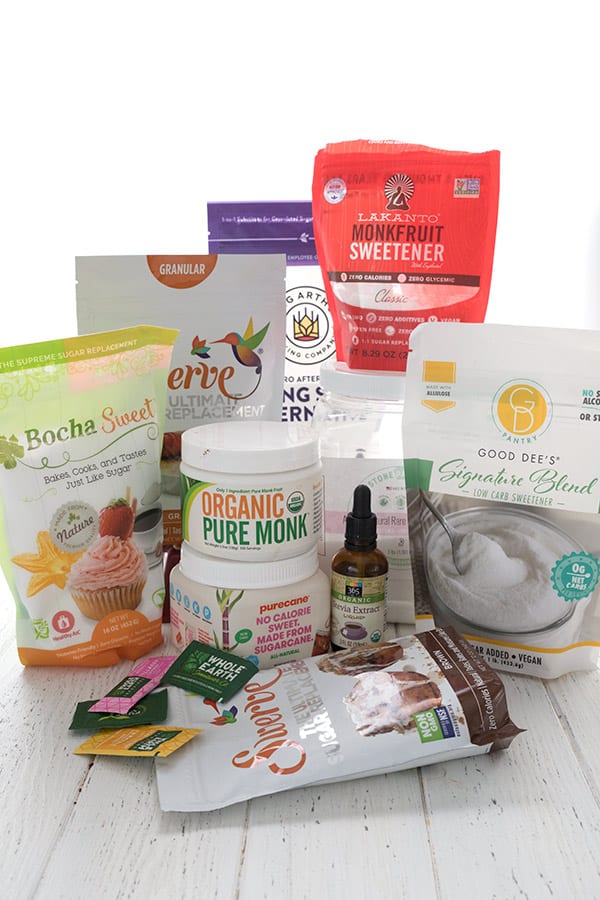
What is the best keto sweetener?
I’m sorry, I simply cannot answer that for you.
I’m not being willful or stubborn, or deliberately withholding information. It’s simply that there is no such thing. Yes, you read that right – there is no such thing as the best keto sweetener.
Here’s why: Everyone experiences these sugar substitutes differently. It’s almost as individual as the individual themselves.
- Some people experience an unpleasant aftertaste with one and not another.
- Some people suffer from GI issues or headaches when consuming certain sweeteners.
- Some people see a blood sugar rise when other people do not.
- Some people may even experience an allergic reaction to certain sweeteners.
With the sugar substitutes market constantly expanding and changing, it’s much more about finding what sweeteners work best FOR YOU.
What are the best sweeteners for keto baking?
Ah, now we’re on to something. This is my territory and one that I have researched extensively. I have experimented with a wide array of sugar substitutes and I can tell you straight up that none of them behaves exactly like sugar.
They all have very different properties and the sweetener(s) you choose will impact the outcome of your recipes. The trick is to understand their different attributes and use them to advantage.
Consider the final product before choosing your sugar substitutes. What are you trying to make? What consistency are you trying to achieve? Do you want it crisp or soft? Chewy or cakey? Should it be gooey or firm?
Most of the popular brands on the market are actually blends of two or more keto sweeteners. For simplicity’s sake, I am going to break them down into their main ingredients.
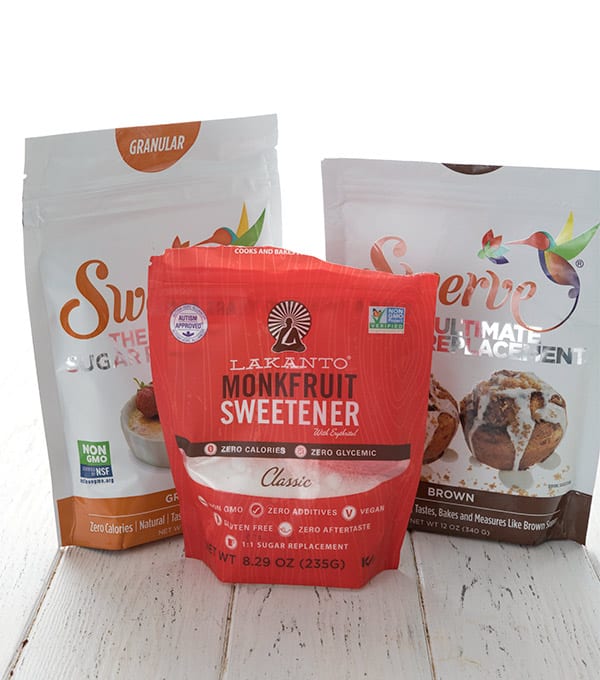
Erythritol
What is it?
Erythritol is a sugar alcohol (polyol) that is naturally present in some fruits and fermented foods. For mass production, it is made by fermenting a glucose syrup with enzymes.
It is unique among sugar alcohols in that it has zero carb impact. Our bodies simply do not recognize it as a carb so it does not impact blood sugar at all. And unlike many sugar alcohols, it does not cause gastrointestinal issues for most people.
How does it work?
Similar to sugar:
– Erythritol mimics sugar in its crystalline structure, so it helps whip air into butter and egg whites.
– It also browns and crisps up nicely and it can even be coaxed into caramelizing.
Differs from sugar:
– It’s only 70% as sweet as sugar, which is why most brands combine it with other sweeteners, to make it measure cup for cup.
– It’s non-hygroscopic, meaning that unlike sugar, it does not attract or hold onto moisture, which can cause baked goods to be dry and crumbly if they don’t have enough fat.
– It can re-crystallize as it cools, particularly in liquid applications like sauces, custards, and ice cream.
– Some people experience a mouth-cooling sensation, similar to sucking on a mint. Not everyone experiences this, and often mixing it with other sweeteners eliminates this sensation.
Major Brand Names: Swerve, Lakanto (this is mostly erythritol… do not be fooled by the fact that it calls itself a “monk fruit sweetener”), So Nourished, ZSweet.

Xylitol
What is it?
Xylitol is also a sugar alcohol found in some fruits and vegetables, as well as in wood and corn. It is usually manufactured commercially from corn or birch trees.
Some, but not all, xylitol is absorbed by the intestines into the bloodstream. This means it can cause some gastrointestinal discomfort when consumed in large amounts. It can also have an impact on blood sugar.
WARNING! The biggest issue with xylitol is that it is highly toxic to dogs.
How does it work?
Similar to sugar:
– It has a crystalline structure so it can whip air bubbles into butter and egg whites. It’s also as sweet as sugar.
– It’s more hygroscopic than erythritol so it attracts moisture and it doesn’t re-crystallize as it cools. Xylitol is great for ice creams and sauces to keep them soft.
Differs from sugar:
– Xylitol doesn’t caramelize or crisp up very well. This can cause problems for baked goods that need a crisp texture, like many keto cookies. They will turn out much more cakey and soft if you use xylitol.
– Definitely do NOT use for meringue, as it will stay gooey and soft, and won’t come off the parchment paper.

BochaSweet
What is it?
BochaSweet is the brand name of a unique sweetener derived from the kabocha squash, a type of winter squash also know as Japanese pumpkin.
Like erythritol, it seems to have little to no impact on most people’s blood sugar. But like xylitol, it can cause some gastrointestinal upset when consumed in large quantities.
In many ways, BochaSweet functions a lot like xylitol (they are both pentose sweeteners), but it does not appear to be toxic to household pets.
How does it work?
Similar to sugar:
– BochaSweet is as sweet as sugar and so can be used as a cup-for-cup replacement, without an apparent aftertaste.
– It is more hygroscopic and doesn’t re-crystallize so it’s great in sauces, custards, and ice creams. (I have started using it in combination with Swerve in all of my keto ice cream… they stay scoopable even straight from the freezer!).
Differs from sugar:
– Just like xylitol, BochaSweet will not crisp up or brown very well. Cookies end up soft and cakey, and meringues are so gooey that they won’t come off the paper.
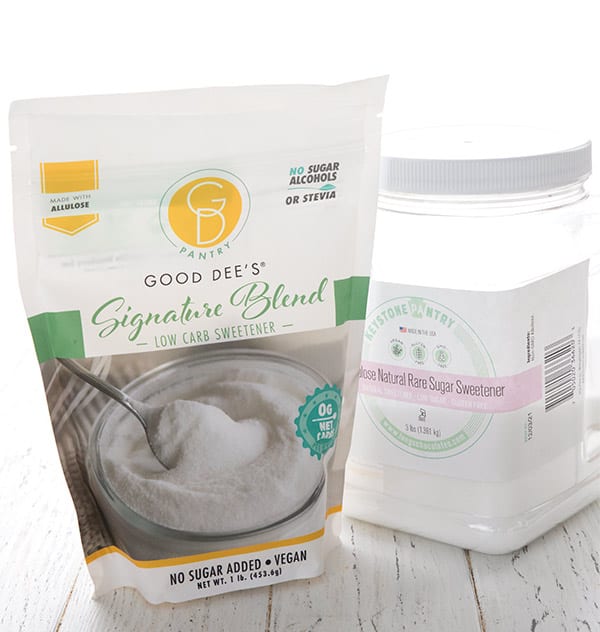
Allulose
What is it?
Allulose is a relative newcomer on the sugar alternative scene and has become incredibly popular. It is a monosaccharide, which means it really is a “sugar”, but one that our bodies don’t treat like a sugar or a carb. It is largely excreted without ever affecting blood glucose levels.
However, I caution you from personal experience that large amounts can cause serious GI distress. Many people don’t seem to suffer from this, but some of us do and it’s…not fun.
So it’s worth testing on yourself in small amounts and building up from there.
How does it work?
Similar to sugar:
– Allulose caramelizes nicely and tends to be hygroscopic, keeping sauces and ice creams soft, and baked goods tender.
Differs from sugar:
– Allulose is only 70% as sweet, which means you need more to sweeten your desserts.
– While it caramelizes well, it doesn’t crisp up well and baked goods tend to be soft and cakey. Even just a little allulose, in combination with other sweeteners, can prevent your cookies from becoming crisp.
– It can over-brown the outside of baked goods, especially the parts that are touching the sides of the pan. Cakes can have a dark, almost burnt appearance, although they aren’t over-cooked.
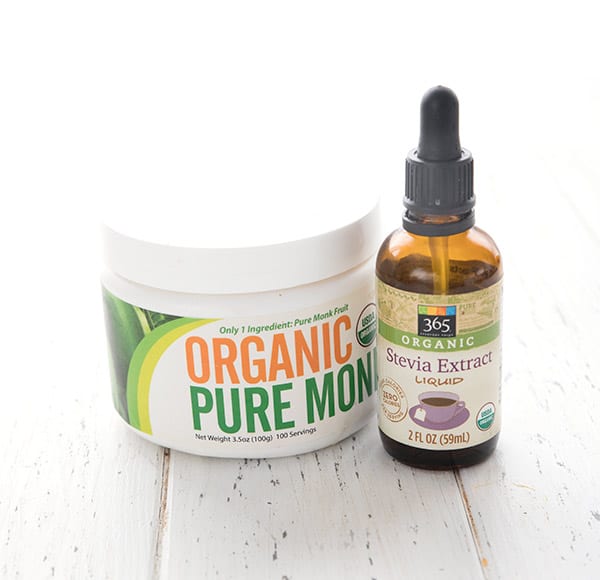
Stevia and Monk Fruit
I am lumping these two together because they have many similar properties and behave much the same way.
What are they?
Both stevia and monkfruit are naturally derived, plant-based sweeteners that are hundreds of times sweeter than sugar. Because they are extremely concentrated, a tiny amount can sweeten a whole recipe.
While that may sound like a good thing, it can have major implications for your keto baked goods. Read on…
How do they work?
Concentrated sweeteners like these have no “bulk” – they have little in the way of weight or volume so they don’t add much to your recipe other than sweetness. They can’t contribute anything to texture or consistency, and they don’t caramelize, crisp, or brown your baked goods.
Bulk is an important factor in anything from cupcakes to frosting. Substituting a non-bulk sweetener means your keto treats may not rise properly, may be more fragile, and may not set properly.
“Monk fruit sweetener”
Please be aware that many brands that bill themselves as “monk fruit sweetener” are actually mostly erythritol. The main ingredient is erythritol, with a little monk fruit to make it sweeter. This means that the sweetener will behave mostly like erythritol.
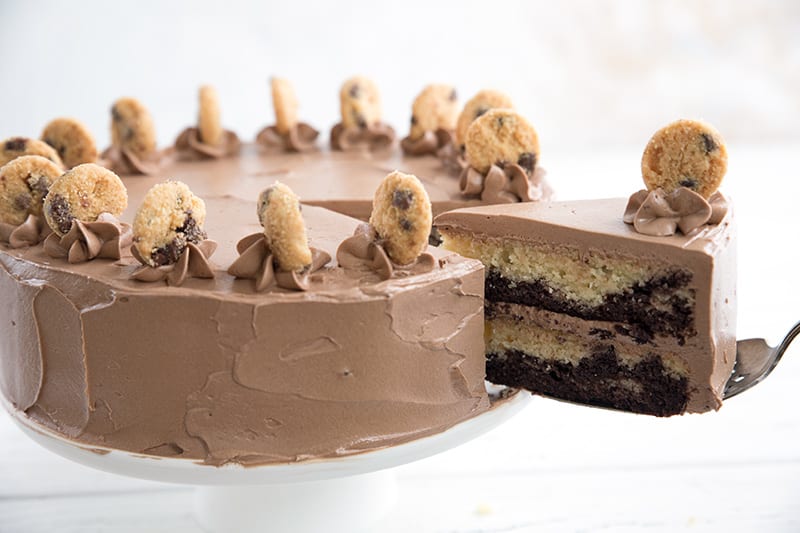
How to use sugar substitutes
I’ve thrown a ton of information at you and I know it’s hard to digest it all. I do this for a living and still I have times when a certain sweetener doesn’t behave the way I think it should. But here’s a quick cheat sheet on what to use when:
Want crisp keto cookies? Use erythritol based sweeteners like Swerve, Lakanto, or So Nourished. Other options will make your cookies soft and cakey. I highly recommend Swerve Brown for the best brown sugar substitute for cookies!
Making a keto cake recipe? Use any sweetener that has bulk (erythritol, BochaSweet, xylitol or allulose), but do be forewarned that some are not quite as sweet as sugar and you may need more of them.
Making a keto frosting? You need a bulk powdered sweetener to give your frosting structure. Erythritol, xylitol, and BochaSweet all have confectioners (powdered) versions. Allulose may as well but I am unsure of brands.
Want a gooey consistency? Try using BochaSweet or allulose, or combine it with another erythritol based sweetener. This combo is perfect for things like keto caramel sauce or my keto pecan pie.
Want keto ice cream that stays scoopable for days? My recommendation is half Swerve and half BochaSweet or allulose. Using only erythritol based sweeteners makes your ice cream rock hard, and all BochaSweet makes it too soft (it stays like soft serve!).
Just trying to sweeten your coffee? Use whatever you like best. They all work well if you don’t need a certain consistency so this is a matter of personal preference.
Still have questions?
Leave a comment and I will do my best to answer!
Adding to the confusion is that many brands on the market are blends of the keto sweeteners I outlined above. Blending sugar substitutes can maximize their sweetness and reduce potential aftertastes.
But I’ve tried such a wide array of sweeteners, I have a good idea of how most of them work. I can also take an educated guess based on the ingredients list. So drop me a line and I will give you all the information I can.

Free Bonus: Secrets to Keto Baking!
Sign up for your favorite recipes delivered straight to your inbox plus get our FREE bonus: Secrets to Keto Baking!

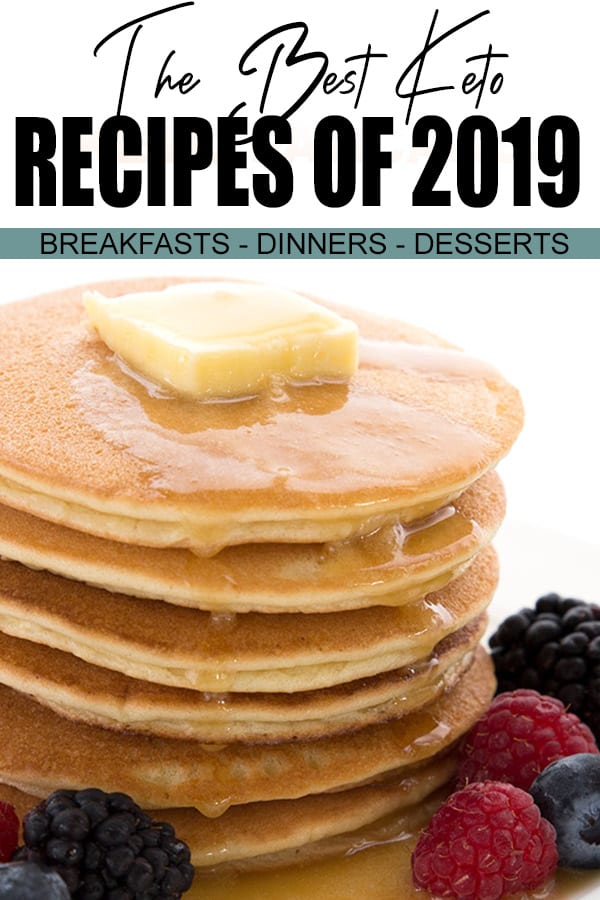


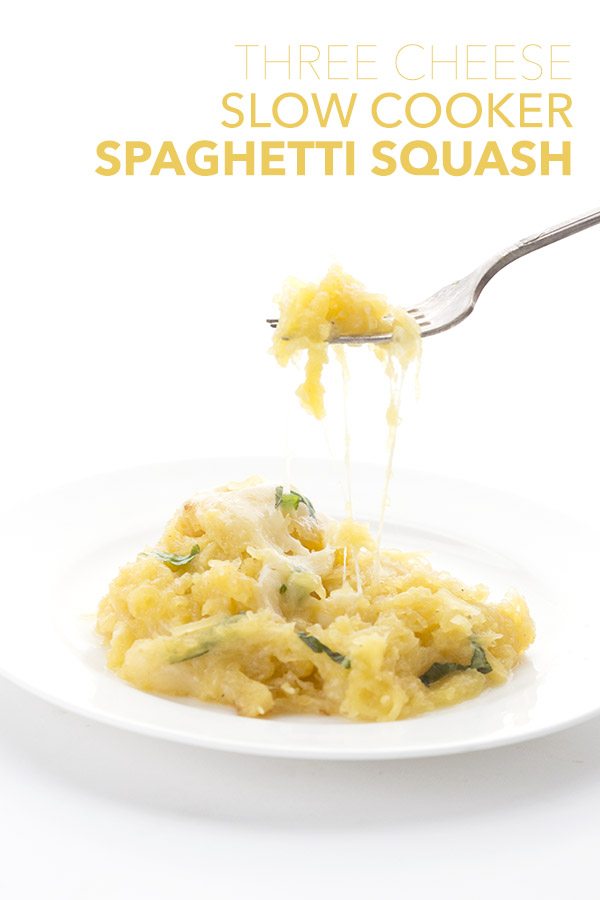










what can we use to make crispy cookies if Erythritol gives us GI problems?
Can you substitute sugar for Swerve?
I am sorry, I don’t use sugar.
What about candies? Would you use a different sweetener for fudge than you would for pralines or peanut brittle?
Good question. For fudge, I like a combo of Swerve (erythritol) and a little allulose to keep it from recrystallizing. But for hard candies, you need an erythritol-based sweetener with no allulose (the new Swerve has a bit of allulose!), because allulose will prevent it from hardening properly.
You say in your recipes allulose or bochasweet. Can you tell me which you prefer and why? I have allulose but never used boccasweet and confused as to which is better for baking and your caramel sauce. I want to try something blended because my Christmas cookies have too much cooling and my pies/cakes have same problem.
To be honest, I now much prefer allulose.
Which one would be best to use to bake a cake if I want it to be soft and moist? Bocha Sweet, allulose, some blend of one of the previous two? I’ve used all erythritol but the next days after baking the cake it gets super dry and grainy.
A mix of erythritol and either BochaSweet or allulose. 50/50.
Would a combination of stevia and monk fruit be a good way to sweeten cranberry sauce?
It won’t thicken the mixture properly. You can use them but you may need to use glucomannan or xanthan gum to thicken the sauce.
Will the new Swerve granulated formula made with erythitol and allulose still work in your baked goods recipes? I’m looking at the scones and pecan butter cookies in particular. I know you said that even a small amount of allulose mixed with other sweeteners can prevent cookies from becoming crisp.
If you want a crisp cookie, you want THIS Swerve –> https://amzn.to/47kkwkT (they’ve got a lot of versions now, which is super confusing, but this one is erythritol and monk fruit).
I read your comment about using whatever you prefer on your coffee. I’ve used Splenda for 5+ years on my coffee and tea — however, it has an added ingredient that kicks you out of ketosis so I need to switch what I use (trying to lose weight). I have tried most that you listed above, and the same spelnda sweetness didn’t happen in my hot raspberry tea – which I need more now with winter coming on. Any suggestions would be hugely appreciated.
Have you tried one that has a blend of alluose or erythritol with monk fruit or stevia? That usually ups the sweetness.
I tried monk fruit with erythritol – and allulose on it’s own — but I’ll keep trying. Thanks for your response! LOVE your recipes!
You can buy pure sucralose that does not contain the ingredient that knocks you out of ketosis. Amazon carries a few different brands. Just check the ingredients list of whichever one you buy.
Hi Carolyn
I’m finding more and more that I am not a fan of eyrthritol based alternative sweeteners. They make my mouth tingle. The only sweetener I can seem to tolerate is liquid stevia. I have noticed that some of your recipes contain egg white protein powder. Do you think egg white protein, collagen, gelatin, or beef protein powder could act as a bulking agent in a cookie or cake recipe to enable use of 1 1/2 tsp of stevia stevia instead? For example if recipe calls for 3/4 c swerve substitute 1/2 cup protein powder and 1 1/2 tsp stevia ? I really want to figure out a way to use stevia.
Thanks for all you do for all of us T2 diabetics! Your recipes are the ones I rely one.
Protein powders like egg white and collagen change the consistency of the baked goods. So I don’t think they would be a good bulking agent. Wish I could help more.
Great information on the different sugar substitutes. I prefer the Swerve and haven’t experimented with the different products – well, when your recipe calls for adding some of the other ones. I am not sure why I don’t use stevia but I don’t. Maybe it makes things too sweet. I really like your recipes – I trust your recipes to help with my t2diabetes. I am off meds and using my diet and exercise to control. Thanks for all the recipes.
Now, to the problem. I think I am developing a reaction to the eyrthritol. I have read the info above. I am thinking it happens when it isn’t cooked – like in icings or just sprinkling confectioner sugar. Any suggestions? I don’t want to stop using the eyrthritol – i have just a tingling in my lips or an itch in the back of my mouth.
Thank you for this comprehensive information on sweeteners. I decided to give Erythritol a miss due to some disturbing body reactions – and discovered it may be a cause of stroke and heart attacks. I am very grateful to learn more about the other available sweeteners.
Hi Carolyn, I’m wondering what type of sweetener would you suggest to use in canning. I would like to can maybe some ketchup, cranberry sauce and maybe green tomato chow. And how long would the shelf live be?
Use allulose or a mix of allulose and erythritol, about 60/40.
Love the fact that you disclose the (for me, too) downside (wow and then some) of allulose and have a huge unopened bag of the stuff. So sad. My question is did BochaSweet have the same reaction for you as the allulose? I only want to keep ice cream scoopable and vodka is not an option. Looking for your insight please.
So I should probably update this… I know I need to for a lot of reasons. So I have grown tolerant of allulose UNLESS I eat too much. I use it frequently now in combination with other sweeteners, without issue. I just started adding it a little at a time to keep recipes softer and/or gooier and found it didn’t cause problems. If I try to eat it full strength (i.e. it’s the only sweetener), it upsets my stomach and I find it has an odd sour taste. Hope that helps!
I have a bunch of tomatoes from my garden & want to make something we use a lot: ketchup. The stumper is sweetening it. I have looked at your recipe using paste and plan to try it this winter, Carolyn. Thank you for that!
I am wondering if anyone in your community has experience making “keto ketchup” from a glut of garden tomatoes. I’m thinking of trying an All Recipes recipe and swapping in Brown Swerve. But I don’t want to blow it! Anyone in your audience have any suggestions? Thank you!!
https://alldayidreamaboutfood.com/sugar-free-ketchup/
Hey Carolyn! I am really struggling – I have food sensitivities (Wheat & corn). This is why I choose Keto. However, my struggle is with sweeteners. Most are derived from (or can come from) corn. So far it looks like BochaSweet, Monk Fruit or Stevia will be my only choices. Most of your wonderful recipes use Swerve – Brown, Crystal or Powder – and Monk Fruit and Stevia don’t provide the bulk for cakes and breads.
Am I right and only limited to BochaSweet?
Thank you
I am sorry, I don’t really have experience with that severe an allergy. While they are derived from corn, it’s usually all used up in the fermentation process. Have you tested it on yourself?
How do we use the new swerve for the recipes in your cookbooks? I know they have changed the formula. I just can’t find any of the old version. Love your recipes. Thanks for all you do.
It honestly depends on the recipe. What are you trying to make?
Not looking at a specific recipe. I recently got two of you cookbooks and just trying to decide what to try. I managed to get one more bag of the original swerve then I’m limited to the new stuff. Made the butter pecan ice cream pie. No one knew it was keto. Everyone loved it.
I am interested in how to use inulin as a sweetner.
I don’t use it.
I found some Swerve Brown and made the walnut brownies. Delicious. But as it sets it gets disturbingly grainy. Same with granular Swerve. I imagine I can use confectioners or lama to which isn’t granular, but what about brown sugar. I have allulose brown sugar but it tastes and smells terrible. Can molasses be added to a non granulated type to mimic brown sugar? I swear I read that but don’t see it here. The granular crunch is really a deal breaker .
Sorry , lama was supposed to be Lakanto
Hi Paula… I don’t get that crunch at all in the walnut blondies. Sounds to me like maybe you are refrigerating them too soon after baking.
Hi Carolyn –
Love your recipes – you are my keto go to! My relationship with Swerve has reached a challenge however – GI issues galore. Have you ever experimented with Mannitol? I know that this too is a sugar alcohol and could also cause an issue, but it sure would be nice to have an alternative if it “bakes” the same.
Thank you for all you do!
LOVE all of your recipes and how helpful you are in giving so many details. I’m wondering if you’ve found a good replacement for the Swerve brown, now that they’ve changed their formula. I really liked the original but I ended up with a bag of the new stuff and it’s just not the same. I used it to make your toffee peanuts and the taste is not as good. I’m thinking about trying my own recipe using plain erythritol and a touch of molasses.